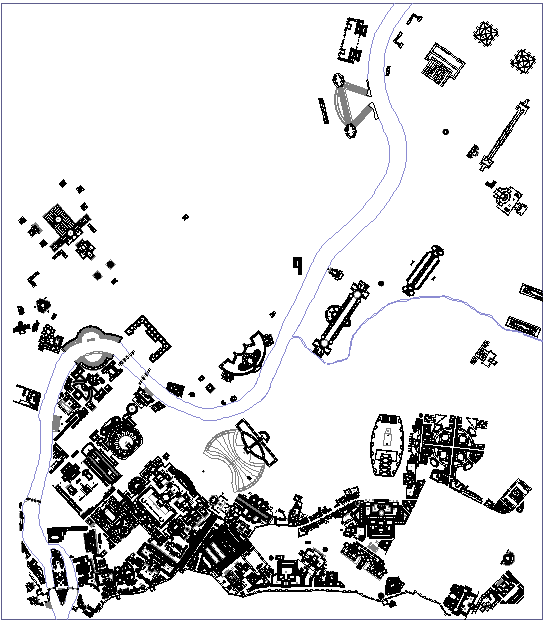| |
75
The first clue appears in the dedicatory letter to Piranesi's volume of plates: The Campo Marzio, he notes, had always been dedicated to the training of youth and military exercise; but during the empire it was opened to other uses--pleasure and spectacle. As more and more buildings were erected for such pursuits, "the Campo no longer appeared to be an appendage of Rome, but, more properly, Rome, the sovereign of all cities, as Strabone has attested."7. Piranesi has faithfully mirrored this inversion, and gone even further. In his variant, the city itself is absent, a blank space on the drawing. 8
This marginal status is consistent historically and is reinforced by an examination of the programmatic legends of the building[s] represented in Piranesi's plan. Buildings of military use are evident, as are those devoted to spectacle and to the culture of the body, but the plan is dominated by the immense figures of two funerary monuments to Hadrian and Augustus. Lying outside the consecrated ground defined by the city walls, the Campo Marzio had traditionally been the site of funerals and burials. Thus the urban texture of the Campo Marzio is also characterized by marginality, by otherness. It becomes the locus of all that is excluded from the city proper: the armories and military exercise yards; the stadia and gymnasia; the amphitheaters and circuses; the gardens and pleasure fountains; the crypts and tombs. The conventional institutions of the imperial city are absent. Save in the funerary monuments, there is no civic presence; streets are nonexistent, as is the whole domestic fabric of the city.
7Piranesi, Dedicatory letter to Robert Adam, Campo Marzio.
8Note, for example, the wall that forms the lower border of the large site plan. This corresponds more or less accurately to the course of the Servian wall erected in the sixth century B.C. and rebuilt in the fourth century B.C. The historic center of the city, the Forum, the Palatine (site of the legendary foundation of Rome), all lie within the walls, to the south of the Campo Marzio, and outside of Piranesi's drawing. The zone is rendered as a blank on his plan. But, further, during the first and second centuries A.D., the city expanded beyond the Servian wall , encompassing much of the area of the Campo Marzio. In 271 a wall, known as the Aurelian wall, was erected. This wall also appears in Piranesi's plan. It does not, however, function as a border, but becomes an integral incident in the plan; it occupies, as far as that is possible, the center.
| |
2013.12.27

After removing all the "the armories and military exercise yards; the stadia and gymnasia; the amphitheaters and circuses; the gardens and pleasure fountains; the crypts and tombs... ...and the funerary monuments," what remains are temples and porticos, offices, stores and warehouses, etc., patrician and plebeian houses, diets, curias, and sundry other governmental buildings, and even a number of streets.
"The level plain of the campus Martius was particularly well adapted to this characteristic form of Roman architecture--the porticus--which conformed to a general model, while varying in proportions and details. The porticus consisted of a covered colonnade, formed by two or more rows of columns, or a wall on one side and columns on the other. lts chief purpose was to provide a place for walking and lounging which should be sheltered from storm and sun, and for this reason the intercolumnar spaces were sometimes filled with glass or hedges of box. Within the porticoes or in apartments connected closely with them, were collections of statuary, paintings, and works of art of all kinds, as well as shops and bazaars. In some cases the porticus took its name from some famous statue or painting, as the porticus Argonautarum.
While the erection of the first porticus in the campus Martius dates from the early part of the second century B.C., the period of rapid development in their numbers and use did not begin until the Augustan era. The earliest of these structures seem to have been devoted exclusively to business purposes. By the time of the Antonines, there were upwards of a dozen in region IX, some of them of great size, and it was possible to walk from the forum of Trajan to the pons Aelius under a continuous shelter. They were usually magnificently decorated and embellished, and provided with beautiful gardens."
Samuel Ball Platner, The Topography and Monuments of Ancient Rome
|
